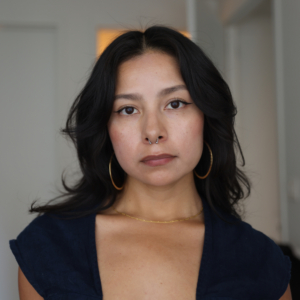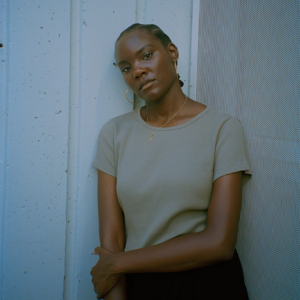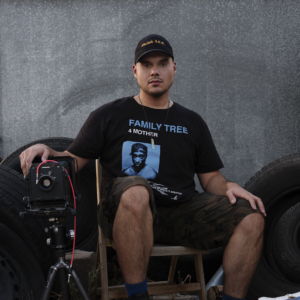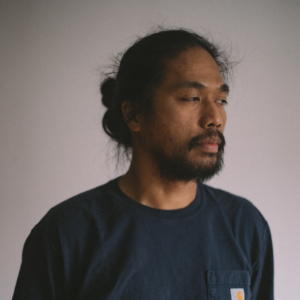
On View:
May 18 to June 30, 2023
WallWorks NY,
15 Canal Place, Bronx, New York 10451


Curatorial Statement
Wanda Raimundi-Ortiz
What does f-stop mean in photography?
(Focal-STOP) The f-stop is the “aperture” opening of a camera lens, which allows light to come in. It also determines how much is in focus in front of and behind the subject (see depth of field). The title of this exhibition is both a play on the camera term and coming to a complete standstill.
Photographers arrest moments in time, ensnaring their subject in the viewfinder and holding it endlessly for us the viewer to bear witness. Photography insists that we come to a full stop—trapping us in its grip, either through pristine beauty, unflinching candor, or mystifying illusion. We gaze upon images that the photographer carefully selects, and through our own knowledge, understand that what we see is just what they wanted us to see. We are left gasping for the just-before and just-after.
The works selected for this exhibition can be viewed as a harnessing of a bleak and solitary existence of fringe communities of color and the underpinnings of the sleek outward-facing veneer that is American life. To come “full stop” before these images brings us to face the faceless and nameless individuals on which this empire is built and sustained. However, there is another reading: one of transcendence as envisioned by the creators behind the lens. Their thirst for an understanding of humanity keeps them scouring hungrily for the right image—the right moment—amid a thousand shutter stops, beyond the genre, beyond the format of portraiture, even beyond the frame and wall.
What struck me immediately across the selections I viewed during my studio visits with each of the artists was a sense of lift—elevation, to be more precise. While many of the subjects are captured within hostile architecture and landscapes, the level of reverence for the sitters in this work is palpable through the lens. These are real people living real lives, attempting to create a semblance of normalcy within the harsh lighting of a crab processing plant, having una cerveza fria (a cold beer) in a humble watering hole in a Southwestern community, or the familiarity of densely crowded neighborhoods. We know these places, spaces, and faces. Our individual lived experiences, when applied to viewing this work, pierces the veil and stretches us past the frame.
This is not to deny the tragedy of displacement and geographic separation of immigrant communities. These works—and the exhibition installation itself—reflect the density and compression of bodies and spaces emphasizing the stretching and pulling of an imagined a life that is beyond what is available to us. This exhibition expects the viewer to crouch down low and stretch up high, to rummage through archives, to dream past our expectations of photography, even past our ideas of love, self, and sanctuary.
Thalia Juárez brings her experience as a documentary press photographer to capture the experiences of women migrant workers at a crab processing plant in a remote location in Maryland. Separated from their families for up to nine months per year, renting a home from their employers and without independent transport, these women work and live daily under grueling conditions. Juárez’s photos capture the isolation and harshness of their environment, but also the small moments of sisterhood and support that they create for each other in this shared space outside of their labor contributions.
Ashley McLean’s tender images of families, specifically Black men and their children at leisure in lush natural settings, become the antidote for the barrage of stigmatizing negative images of Black men across media. In these works, McLean cradles her subjects gently in foliage and warm light as a child plays in a garden under a parent’s watchful eye in the distance. The work normalizes families at rest and deserving of proximity to nature and beauty. McLean’s photographs serve as a sanctuary.
Ryan Frigillana’s suite of photos are inspired by his own Filipino family narrative and pushes against the images he found while researching Filipinos in the Library of Congress. Those images depict people at work in large fields, stooped over, working, often photographed from behind and backlit, presented as much a part of the landscape as faceless mounds or beasts of burden. He counters these images with photos of his father tending to his own abundant garden in a halo of mist from a garden hose. Frigillana mines archival images of his immediate family and juxtaposes them against institutional images to rehumanize the individuals who are oft overlooked and underappreciated.
Mateo Ruiz Gonzalez’s Chilluns’ Croon (2021) series focuses on the town of Wilson, North Carolina, a predominantly African American community, and specifically the Louis Neil museum, created in his garage. Neil has dedicated his life to archiving and preserving the stories of African Americans in Wilson. The town was included in what was known as The Negro Motorist Green Book, first published in 1936 and last published in 1966, that listed spaces where Black folks were welcome. (Note: It deserves mentioning that four issues have been reprinted and are currently in circulation.)
Pratya Jankong’s autobiographical photography and installation work developed from the invasive procedures of naturalization in the United States that he and his partner endured. Expected to produce evidence of a loving relationship to caseworkers, he documented banal minutiae such as his view while sitting in a waiting room or intimate moments with his wife. These moments prompted Jankong to conflate those images with copies of filed documents involving their case and create variations of a physical timeline that are at once tender and dehumanizing.
Eduardo Rivera’s work is based on his family’s migration from Mexico and settlement in Phoenix, Arizona. He uses old family photographs as archives and returns to them as an anchor for his practice, pointing to the lives and intimacy that his family built together. His work explores moments where time can be open and also examines how bodies and architecture echo each other. Rivera says, “I am drawn to the poetics of this place, and how elements of metaphorical light and evidence of people act as guideposts”.
Samantha Box is a citizen of multiple diasporas, Indians from Trinidad/Jamaican, and examines how identity and knowledge shift across borders. She uses photographs to find conclusive points around people and personal landscapes, utilizing mirrors, objects, and textiles that are referential to family life. Box’s work also asks what is True Land. Where do we come from, how do we create spaces of Caribbean paradise and artifice that occur within the studio, as well as collapsing the body until it resists identity?
Àngel Añazco’s Renacimiento (Rebirth) (2021–ongoing) series examines the artist’s Andean ancestry and pre-colonial recognition and respect of the third gender, validating their gender transition and drawing connections to the celestial. Through digital painting over self-portraiture, the artist reimagines themself as divine, other-worldly visions inspired by conflating ancestral folklore and futurist gestures.
Ana Vallejo’s intuitive photo collages speak to shared trauma, love, addiction, and self-medication. Her most recent work examines universality through collaborative experiments with female-presenting friends and commonality, and asks how trauma builds resistance, and examines the forces that connect us.
Tanya Bindra’s photojournalistic approach to her family life in London as a Southeast Asian interrogates the complex relationship between her grandfather, the British royal family, colonial rule, and the impact of colonization within migrant communities both here and abroad. The similarities of migrant communities across international divides is strikingly similar to the patterns observed in an equally populated city like New York, and is evidenced in her claustrophobic organizing of individual images that feel cast away and precious only to those with intimate connections to the photos.
This exhibition and publication are a culmination of ten early career artists whose excellence in the field of photography has been recognized by a jury of professionals drawn from ninety-three applicants across the state of New York. Accompanying this recognition comes an unrestricted cash prize, a guest-curated exhibition, and a feature in En Foco’s biannual journal Nueva Luz. I would personally like to extend my gratitude for the invitation to curate this exhibition. As an artist, scholar, and Bronx-bred native, I felt deeply honored to be entrusted to thread these stories together cohesively with love and care.

Àngel Añazco (she/her, they/them) is an Ecuadorian-American multidisciplinary artist based in Brooklyn, New York. Raised between Ecuador and the United States, Añazco received her BFA from Parsons School of Design, The New School, New York, New York, in 2017. She believes in using tools such as photography, painting, and performance to further expand on her mission for accurate representation through the lens of life experience and constructed realities. Autonomy over her image is at the core of her artistic practice with the purpose of taking control of her narrative in response to mainstream appropriation. Past clients and publications include TIME, Allure, The FADER, Paper Magazine, V Magazine, Highsnobiety, Smashbox Cosmetics, and Milk Makeup. Añazco exhibited with The Latinx Project at New York University, New York, New York, in 2022, and was awarded the Giant Artists x Peerspace “Space for Change” Mentorship in 2021.

Samantha Box (she/her) is a Jamaican-born, Bronx-based photographer. She holds an MFA in advanced photographic studies from ICP-Bard College, New York, New York, and a certificate in photojournalism and documentary studies from the International Center of Photography, New York, New York. Her work has been widely exhibited, most notably, at the Houston Center of Photography, Houston, Texas; the DePaul Art Museum, Chicago, Illinois; the Leslie-Lohman Museum of Art, New York, New York; Light Work, Syracuse, New York; the Open Society Foundation and the International Center of Photography, New York, New York, and is in the collection of the Museum of Fine Art, Houston, Houston Texas. Box has been an artist-in-residence at The Center for Photography at Woodstock, Kingston, New York and at Light Work, and was a Bronx Museum Artist in the Marketplace (AIM) fellow. She will be in residence at the Visual Studies Workshop, Rochester, New York, in 2023. She has been awarded a NYFA/NYSCA Fellowship in Photography twice, in 2010 and in 2022.

Ryan Frigillana (he/him), born in Iligan City, Philippines, is a New York-based visual artist working with photography and image archives. Informed by his experiences as a first-generation American, his work reflects on labor, faith, memory, and home in relation to the Filipinx Diaspora. Raised in Long Island, Frigillana draws from his religious upbringing and familial relationships to explore both the inheritance and construction of cultural identity as observed through diasporic life. He initially worked in horticulture for ten years while studying in the medical field before eventually pursuing art, graduating with a BFA in photography and related media from the Fashion Institute of Technology, New York, New York, in 2020.

Thalía Juárez (she/her) is a documentary photographer and multimedia artist based in Harlem, New York. Born and raised in Southern California, Juárez developed an early interest in photography and storytelling from her father. She studied journalism at The University of Texas at Austin, Austin, Texas, where she honed her skills in photojournalism working for the student newspaper. She began her career as a multimedia journalist in rural Pennsylvania, covering the opioid crisis, the 2016 election, and everyday life in Appalachia. She then moved to Maryland where she was drawn to the topic of migration and labor, among other social issues. Throughout her career, she has been passionate about documenting the daily lives of Latinx communities.

Ashley McLean (she/her) is an artist based in New York City. She received her BFA in Photography and Video from the School of Visual Arts, New York, New York, and in 2021 studied at Universität der Künste Berlin, Berlin, Germany. Her camera renders her subjects in contact with the natural world with tenderness and sensitivity as her guiding ethic. McLean’s work calls attention to notions of masculinity, Black identity, and subjectivity in art. Her work has been shown in group exhibitions in the United States and abroad. In 2022, she was honored as a laureate for the Dior Prize for Photography and Visual Arts for Young Talents.

Eduardo L Rivera (he/him) was born in Phoenix, Arizona. His photographs have appeared in Aperture, Capricious, Der Greif, and The New York Times Magazine with solo and group exhibitions throughout the United States. He was a recipient of the Massachusetts Cultural Council Fellowship, an artist-in-residence at MASS MoCA, North Adams, Massachusetts, and an alumni of the Skowhegan School of Painting and Sculpture, Madison, Maine. He holds a BFA in photography from Arizona State University, Tempe, Arizona, an MFA in Photography from the Massachusetts College of Art, Boston, Massachusetts, and a certificate in teaching from Harvard University, Cambridge, Massachusetts. Rivera is currently a visiting assistant professor in photography at the Rochester Institute of Technology, Rochester, New York.

Ana Vallejo (she/her) is an interdisciplinary mixed media artist and conceptual documentary photographer from Colombia based in New York. Having a background in biology, she roots her practice in researching trauma, brain plasticity, Jungian psychoanalysis, and human consciousness. She incorporates experimental and holistic approaches to investigate the potential that art, social bonds, and collective experiences offer to heal. Growing up with a schizophrenic father in an anxious family system, and in a country that has normalized war and violence, Vallejo is drawn to how neglect and trauma affect emotions, mental health, sense of worth, and relationships. Vallejo’s works have been exhibited in festivals and venues including PhotoVogue Festival, Milan, Italy; PhMuseum Days International Photography Festival, Bologna, Italy; In 2021 Ana was selected as an artist for Foam Talent, received the Excellence in Multimedia Storytelling award from CENTER Santa Fe, Santa Fe, New Mexico, and earned first prize for The PhMuseum Women Photographers Grant.

Tanya Bindra (she/her, they/them) is a Swiss-Punjabi photographer and filmmaker with roots in Canada, the United Kingdom, Tanzania, and New Jersey in the United States. Her documentary practice and moving-image work explore the production of global cultures, with particular emphasis on the everyday spirituality of diasporic communities. Bindra started her career as a multimedia journalist, spending a decade reporting on breaking news, conflict, and migration in over twenty countries across West and Central Africa, South Asia, Europe, Central, and Northern America, for such outlets as The New York Times, The Washington Post, Newsweek, and on advocacy campaigns with the American Civil Liberties Union (ACLU), Médecins Sans Frontières (MSF), UNICEF, and others. Prior to turning to documentary work, Bindra provided crisis support and legal accompaniment services to survivors of sexual assault and later continued advocacy work at an immigrant workers’ center. She holds a BA from McGill University, Quebec, Canada, in international development and gender, sexuality, feminist, and social justice studies.

Pratya Jankong (he/him) is a largely self-taught photographer from Thailand who moved to New York to pursue an MFA in photography. His recent work explores permutations of immigrant joy, family intimacy, and memory. With his in-depth long-term projects, Jankong seeks to create nuanced visual documents that celebrate the complexity and resilience of marginalized communities. In 2019, Jankong’s documentation of Black Lives Matter was featured in the Thai edition of National Geographic. His project Bed Checks which deals with his own experience of immigration—was selected for the CENTER Santa Fe Portfolio Review. Bed Checks will also be featured in a solo exhibition at Dubrek in Derby, England, as a part of the FORMAT International Photography Festival in 2023.

Mateo Ruiz Gonzalez (he/him) is a lens-based artist and researcher from Bogotá, Colombia, currently based in Brooklyn, New York. After earning a degree in art history from Universidad de Buenos Aires (UBA), Buenos Aires, Argentina, in 2013 he moved to Brooklyn, New York, to complete a graphic design portfolio development program at Shillington School in New York City. Ruiz Gonzalez works between Colombia and the United States researching and developing photographic essays. He is the co-founder and photo editor at Antics Publications, an independent photography publisher based in Bogotá, Colombia, and Brooklyn, established in 2018. Antics focuses on creating an inclusive photography community and producing high-quality photography publications. In 2022, Ruiz Gonzalez’s project Chilluns’ Croon (2021) was named as a finalist for the Aperture Portfolio Prize, OD Photo Prize, Verzasca Foto Festival, New York Foundation for the Arts (NYFA) Fellowship 2022, and Film Photo Award – Visionary Project. The project was the winner of Photo Collective Australia International Prize, Urbanautica Institute Awards.

Wanda Raimundi-Ortiz (she/her, they/them) is an interdisciplinary visual artist whose work pulls from seventeenth- and eighteenth-century European portraiture, comic books, sketch comedy, folkloric dance, and installation to address race, bias, trauma, and healing. Her work has been exhibited at the Smithsonian National Portrait Gallery, Washington, D.C.; National Museum of Women in the Arts, Washington, D.C.; Museum of Arts and Design, New York, New York; Garage Museum of Contemporary Art, Moscow, Russia; Corcoran Gallery of Art, Washington, D.C.; Gyeongnam Art Museum, Changwon, South Korea; Museo de Arte de Puerto Rico, San Juan, Puerto Rico, among others. She earned her MFA from Rutgers University Mason Gross School of Art, New Brunswick, New Jersey.
WALLWORKS NEW YORK is a contemporary art gallery in the South Bronx, dedicated to bringing art back uptown. In the vein of Fashion MODA, WALLWORKS is dedicated to showcasing new and exciting art from both emerging and established artists, mixing “downtown” sensibility with “uptown” style; a place for exploration. The passion project of legendary Graffiti pioneer CRASH and entrepreneur Robert Kantor, WALLWORKS seeks to remind people of the rich culture of the Bronx, and encourage everyone to take a trip Uptown!
Bronx Kreate Hub is a workspace and community incubator in Mott Haven that supports the growth and continued success of local artists, creatives, and entrepreneurs. Community members represent a diverse array of specialties, including animators, graffiti artists, photographers, designers, and community organizations like En Foco and the Mott Haven Film Festival among others. Studio spaces are available at an array of affordable price points, reaffirming Kreate Hub’s commitment to building community through access.
“F[ull] Stop: Recalibration,” a thought-provoking roundtable discussion featuring a select group of 2023 Fellowship Awardees. We will delve into the power of art for healing, exploring how these artists incorporate catharsis into their creative practices.
This engaging conversation will be led by curator Wanda Raimundi-Ortiz, and joined by artists Tanya Bindra, Samantha Box, Ryan Frigillana, Pratya Jankong, Ashley McLean, and Ana Vallejo—six of the ten fellowship awardees—as they share their experiences and perspectives. The roundtable will be followed by a Q&A session, allowing you to actively participate in the dialogue.
En Foco is supported in part with public funds from the New York City Department of Cultural Affairs, in partnership with the City Council, National Endowment for the Arts, New York State Council on the Arts with the support of Governor Kathy Hochul and the New York State Legislature, BronxCare Health System, The Mellon Foundation, The Joy of Giving Something, Inc., New York Community Trust Mosaic Network & Fund the Phillip and Edith Leonian Foundation, Ford Foundation, The Lily Auchincloss Foundation, Mertz Gilmore Foundation, Jerome Foundation, The Hispanic Federation and Aguado-Pavlick Arts Fund.